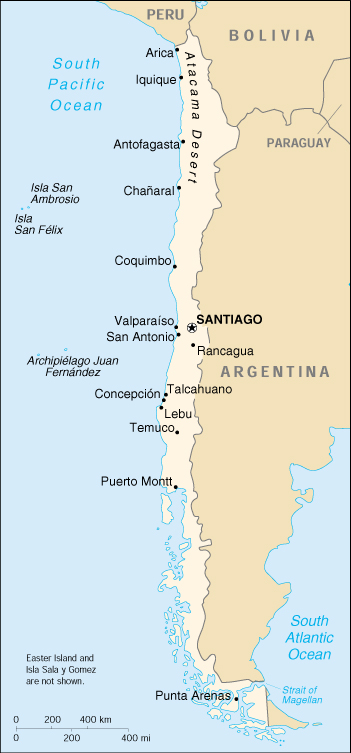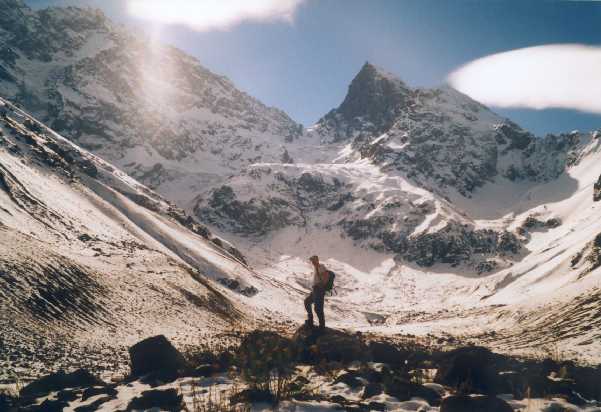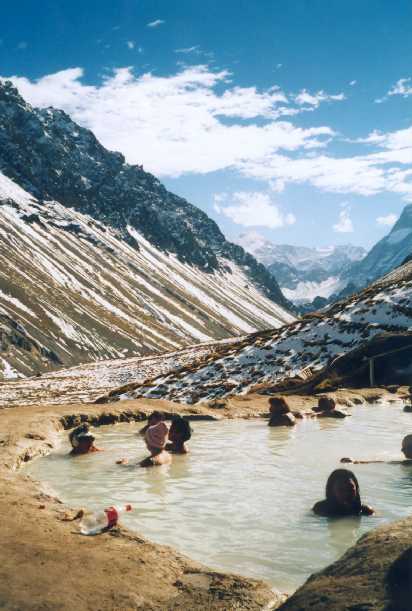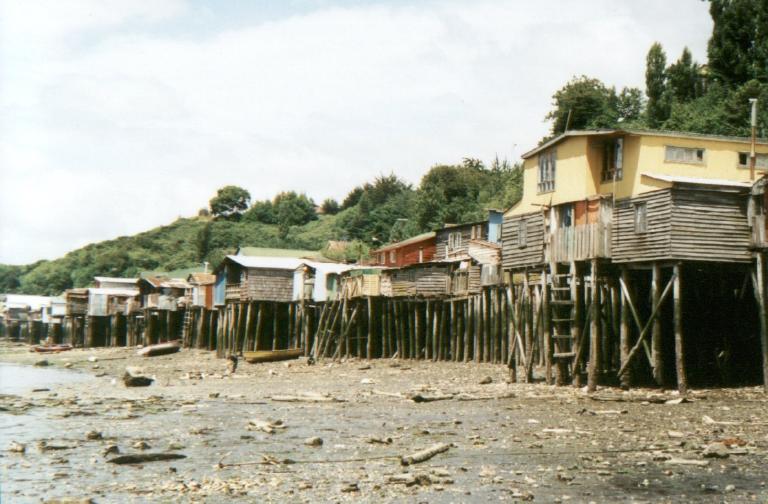
| North | Middle | Santiago | South |
We did a number of trips in the far north, including driving a circuit from Iquique to Arica via the alti-plano. This was a very varied trip that took in such disparate destinations as Pica (a desert oasis town), the ghost towns of mining days, the Salar (salt lake) de Surire, massive Inca geoglyphs, remote alti-plano villages and of course Los Parques Nacionales Lauca y Isluga. The road that heads north along the Bolivian border is encrusted with tall snow-capped volcanoes, extensive grassland for the grazing llamas and high lakes. In particular, on October 12 at the foot on the massive Volcan Parinacota on the shores of Lago Chungara, I asked Jon to marry me. Luckily for him he said yes, otherwise I may not have let him back in the tent. Travelling south again from Arica to Iquique we found a real gem in Pisagua. A small coastal town of only 150, the gruesome history of Pisagua as a major destination for political prisoners during the Pinochet regime is still tangible, but fascinating. This town which was once a very important dock during mining days still retains a sense of its past, echoed in the beautiful old theatre and dock market, now converted into a library. Another altiplano trip was around Copiapo, by this time we had a digital camera so have plenty of photos
Another old time favourite, especially amongst backpackers, is San Pedro de Atacama, a small desert town dwarfed by the slopes of Volcan Licancabur which towers at 6000m. San Pedro is bordering on being sleepy and is a great place to just hang out and enjoy the slow pace of village life, although with the ever increasing tourist presence, it is hard to know how long it will still like this. For more travel stuff on the alti-plano outside of Chile, check out my Bolivia section.
 My current home is Santiago, the capital of Chile, where I work at the
European Southern Observatory. Despite its bad publicity about pollution,
Santiago is actually a very pleasant place to live with all the
advantages of a big city, with the joys of the mountains and the coast
only a short drive away. Santiago itself has many attractions for
the visitor including a variety of interesting museums, galleries,
markets and scenic spots. However, at the end of the day, Santiago
is a big city and you usually want to escape at the weekends, and
there are lots of possibilities....
My current home is Santiago, the capital of Chile, where I work at the
European Southern Observatory. Despite its bad publicity about pollution,
Santiago is actually a very pleasant place to live with all the
advantages of a big city, with the joys of the mountains and the coast
only a short drive away. Santiago itself has many attractions for
the visitor including a variety of interesting museums, galleries,
markets and scenic spots. However, at the end of the day, Santiago
is a big city and you usually want to escape at the weekends, and
there are lots of possibilities....
 The Cajon del Maipo is a particular favourite with city-dwellers,
because after only an hour of driving you can leave the noise and smog
behind and be lost in the hills. The Cajon has many pleasant spots,
I often go climbing at Piedra Romel and Las Palestras , you can wine taste at
the Concha y Toro vineyard or bathe in some of the many hot springs.
Of course, the hiking is spectacular, the valley floor rising steeply
to a clutch of 4000 - 5000m peaks. On the right is a photo of the
Banos Colinas, taken in May 2000, when we were visiting a village
called Banos Morales. Above is a picture of Jon taken at the
lake on the hike up to Cerro Morado, also in May when the early winter
snow made this a particularly impressive walk. In the spring, the
walk is very different - in the place of snow is an colourful carpet
of mountain flora.
The Cajon del Maipo is a particular favourite with city-dwellers,
because after only an hour of driving you can leave the noise and smog
behind and be lost in the hills. The Cajon has many pleasant spots,
I often go climbing at Piedra Romel and Las Palestras , you can wine taste at
the Concha y Toro vineyard or bathe in some of the many hot springs.
Of course, the hiking is spectacular, the valley floor rising steeply
to a clutch of 4000 - 5000m peaks. On the right is a photo of the
Banos Colinas, taken in May 2000, when we were visiting a village
called Banos Morales. Above is a picture of Jon taken at the
lake on the hike up to Cerro Morado, also in May when the early winter
snow made this a particularly impressive walk. In the spring, the
walk is very different - in the place of snow is an colourful carpet
of mountain flora.
Also in the middle, a favourite place for real cowboy culture is Olmue, a few hours drive from Santiago. There are more photos of this, including ones of me in a very silly hat we we climbed La Campana.
Not really in the middle, rather far out in the Pacific, Easter Island is a unique experience.
|
|
|
|
|

Further south is the important port of Puerto Montt. This is also the main access point to the Isla Grande de Chiloe known for its brightly coloured stilted buildings, wooden churches and curanto. What brought us to Puerto Montt in January 2001 was catching the Navimag boat south through the Chilean fjords to Puerto Natales. The trip takes around 4 days and, as long as the weather holds, takes you through breathtakingly remote channels of mountains and glaciars. The main attraction in southern Patagonia is the Torres del Paine NP, a must-see for hiking enthusiasts. We spent 9 days in the park in total, including a 6 day hike around the 100km Paine circuit, which takes you past breathtaking granite spires, turquoise glacial lakes and immense ice-fields. Then on to the end of the world (at least it felt like it!) at Punta Arenas, where the only ones having a ball were the penguins!